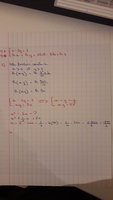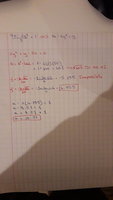Hey !
So I have the following system :
[MATH] x - 2y = 1 [/MATH][MATH] ln(x) + ln(y) = 3ln(5) - ln(10) + ln(4) [/MATH]
So I'll explain what I tried first :
First attempt :
Figured out that x and y can't be negatives if I remember the lessons correctly.
Then, I got rid of the ln function and got this :
[MATH] x + y = 5^3 - 10 + 4 [/MATH]
With the new system, I got the following answer :
[MATH] y = 118/3 [/MATH][MATH] x = 239/3 [/MATH]But that's wrong.
On my second attempt I tried this :
[MATH] ln(xy) = ln(5^3/10)(4) [/MATH]followed by
[MATH] xy = 50 [/MATH]
With the new system, I got the following answer :
[MATH] y = 49/3 [/MATH]But I didn't even bother to continue this as those are the approximate forms I should be getting (They're on the screenshot I sent ) :
Can someone tell me what I'm doing wrong ? I wish I could focus a bit more on this exercice and figure it out myself but I got a lot to study for tomorrow and I can't stay stuck on this too long.
So I have the following system :
[MATH] x - 2y = 1 [/MATH][MATH] ln(x) + ln(y) = 3ln(5) - ln(10) + ln(4) [/MATH]
So I'll explain what I tried first :
First attempt :
Figured out that x and y can't be negatives if I remember the lessons correctly.
Then, I got rid of the ln function and got this :
[MATH] x + y = 5^3 - 10 + 4 [/MATH]
With the new system, I got the following answer :
[MATH] y = 118/3 [/MATH][MATH] x = 239/3 [/MATH]But that's wrong.
On my second attempt I tried this :
[MATH] ln(xy) = ln(5^3/10)(4) [/MATH]followed by
[MATH] xy = 50 [/MATH]
With the new system, I got the following answer :
[MATH] y = 49/3 [/MATH]But I didn't even bother to continue this as those are the approximate forms I should be getting (They're on the screenshot I sent ) :
Can someone tell me what I'm doing wrong ? I wish I could focus a bit more on this exercice and figure it out myself but I got a lot to study for tomorrow and I can't stay stuck on this too long.



